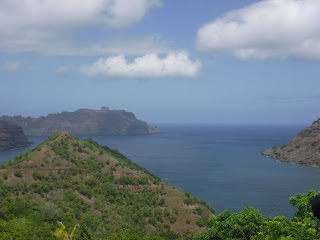26 March -- Last Port of Call -- Taiohae, Nuku Hiva, Marquesas
Well, we knew it had to come to an end and here we are at Nuku Hiva which is the largest island in French Polynesia after Tahiti. We had a lovely entrance into the bay this morning with the sun helping to highlight the mountains.
After a late breakfast, we went into town and looked around. We hiked up a small mountain that had the Tiki Tuhiva on the top overlooking the bay. This is the highest sculpture in all of French Polynesia.This is considered a sacred ground of the Marquesians and has a number of smaller tiki statues in the area. It also has the "octopus" that represents the linkage of all the islands from New Zealand, to Easter Island, to Tonga to Hawaii with Raiatea the center, the head of the octopus. This is the Polynesia Triangle that indicates how the seafaring tribes used the stars and winds to arrive in the 118 Polynesian Islands.
Then we met up with our tour guide, Aniata, her name translates to "image of the sky". She was excellent and gave us a wonderful insight into the Marquesian culture and history. Nuku Hiva is the admistrative capital of the Marquesas. It has the only staffed hospital and helicoptors to service the other12 islands, of which only 6 are inhabited.
We left the city of Taiohae with a population of 2200 and began our upward trek on a curvy mountainous road to about 4000 feet above sea level for some panoramic views of the bay, our ship and the city.
From there we went to the next bay and the Taipivai valley which is where Herman Melville was stranded and wrote about his adventures with the indigenous people. The valley is lush and a chief agricultural area for the island. Main crop is coconuts and fishing, principally tuna! They have an ongoing feud with the Chinese and Japanese that tend to fish the island's waters. The town of Taipivai has the remaining 300 people as residents and that's it for inhabitants
Then back to the city for a tour of the Cathedral, that was built in the 1800s. The entrance towers is all that remains of the original structure. The new church was built in th 1970s and has a stone from each of the 12 islands around its perimeter facade. The statues are made from rosewood, ironwood and breadfruit tree woods and carved with a Polynesian persona, and not a typical Catholic imagery. The majority of Marquesians are Catholic but still retain a respect for the Tiki culture and traditions.
So that's it folks! Pictures are a slow download and are coming soon and we've been advised that satellite connectivity will be spotty as we cross the Pacific. Next stop San Diego in a week!!













Comments
Post a Comment